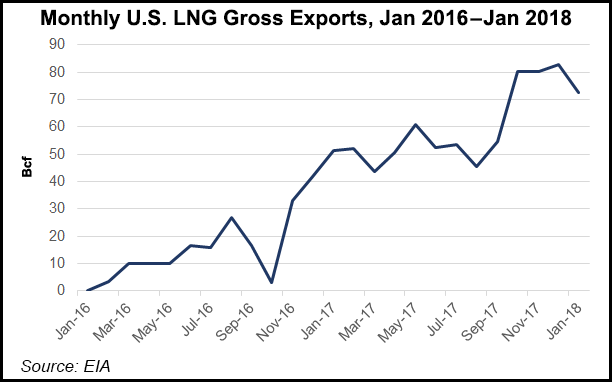Markets | Infrastructure | LNG | NGI All News Access | NGI The Weekly Gas Market Report
U.S. LNG Exports Could Produce $3.3T in Economic Benefits by 2050, Study Finds
The cumulative economic benefits through 2050 from U.S. liquefied natural gas (LNG) exports could be as much as $3.26 trillion, according to an analysis released Tuesday by LNG Allies.

ICF Inc. based its analysis on the reference case, high oil and gas case, and high oil price case included in the U.S. Energy Information Administration’s (EIA) Annual Energy Outlook 2018 (AEO2018), which was released in February.
Considering the entire value chain (LNG and natural gas supply), the cumulative economic benefits from U.S. LNG exports would range from $1.66 trillion to $3.26 trillion from 2013 to 2050, according to the report. The cumulative impact from LNG plans would range from $716 billion to $1.27 trillion.
“U.S. LNG exports are driving the transformation of the international gas trade to an increasingly well-connected global market,” said LNG Allies CEO Fred H. Hutchison. “This updated report shows LNG exports also provide important economic benefits to the United States, by stimulating job creation, increased economic activity, and tax revenues.”
LNG Allies is a nonprofit organization that supports domestic gas exports.
AEO2018 indicated that the United States, which has been a net energy importer since 1953, will transition to become a net exporter by 2022 or earlier, based on continued development of domestic shale and tight oil and natural gas resources, paired with modest energy consumption growth.
In November, the International Energy Agency projected that the country will become the largest LNG exporter by the mid 2020s.
U.S. LNG also is accelerating a major structural shift toward more flexible and globalized gas markets, IEA said, mirroring projections by EIA and other forecasts, including by BP plc and ExxonMobil Corp.
© 2024 Natural Gas Intelligence. All rights reserved.
ISSN © 1532-1231 | ISSN © 2577-9877 | ISSN © 1532-1266 |
